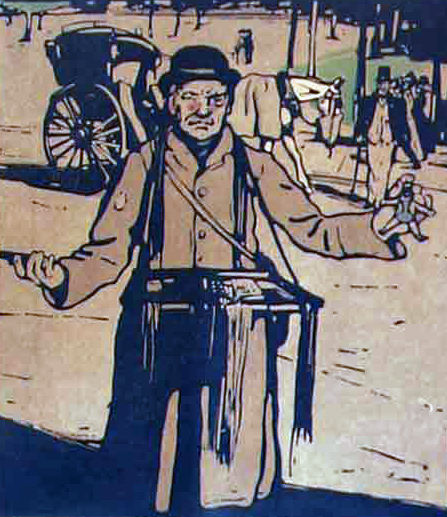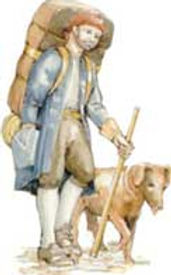Hawkers, pedlars and costermongers
Links
Lifted from the net ...
“In mid-19th century statutes, hawkers and pedlars are usually referred to together - as people who were required to pay a license fee to sell their goods itinerantly. We have already seen that the difference between the two (from an 1895 quotation) is that a hawker carries his goods on an animal or cart, while the pedlar uses a pack. From examples illustrating the historical development of hawker, it appears that the word had a negative connotation from early days, in contradistinction to pedlar/pedler. A statute from the days of Henry VIII spoke of "Sundry evill disposed persons, which commonly beene called hawkers ... goe about from place to place within this Realme, using buying and selling of Brassse and Pewter." By the late 17th century, we have the following from the London Gazette: "A sort of loose and idle persons, called Hawkers, who do daily publish and sell seditious Books, contrary to Law." The OED defines the hawker as one who "goes from place to place selling goods, or who cries them in the street." So, the word goes back either to the sound of the person (he sounds like a hawk) or, more likely, the fact that such a person was always concentrating on his prey, like a hawk. In any case, the less derogatory usage of the term seems to arise in the 19th century, where the hawker is just one who sells goods more demonstrably than the peddler." Bill Long
“Although street selling was a common practice in London throughout the nineteenth century (and still an important form of trading in the city today), most other towns and cities in Britain enforced strict regulations on the practice from the 1820s onwards. In provincial towns, new market halls were constructed in response to middle-class fears of civil disorder, insanitary practices and fraud associated with the open-air markets of the eighteenth and early nineteenth centuries. The lavish nature of this license indicates the new importance attached to the regulation of street trading in provincial towns in the mid-Victorian period. It also might have acted as a deterrent to the practice of street trading itself: the form would have been expensive to produce; the license very expensive to obtain by any prospective hawker.”
“Board of Commissioners of Hawkers, Pedlars, and Petty Chapmen Licences on hawkers and pedlars were first instituted in 1697 for a year to help pay the interest on the debt incurred on the transport services during the Irish campaign. Initially, they were managed under the control of the Board of Transportation but on their renewal in 1698 the Treasury appointed a new Board of Commissioners of Hawkers, Pedlars and Petty Chapmen. The duties were renewed for varying periods until 1716 when they were made permanent. In 1810 the Hawkers and Pedlars' Board was abolished and its work taken over by the Board of Hackney Coach Commissioners.
In 1832 licensing work passed to the Board of Stamps and the duties were successively administered by the Board of Stamps and Taxes in 1833 and the Board of Inland Revenue in 1849. In 1864 the stamp duties on hawkers and pedlars' licences were converted to excise licence duties and in 1870 these duties ceased to be levied on licences to hawkers on foot. Such traders were subsequently required to take out a certificate from the police under the Pedlars' Act 1870. The licence duties on other hawkers (e.g. those travelling with a horse) remained in force, collection having passed to the county councils under the Local Government Act of 1888. Administrative responsibility passed from the Board of Customs and Excise to the local authorities in 1950 following the Finance Act 1949. Hawkers' licences were finally abolished under the Local Government Act 1966.”





dictionary definition
A person who travels around selling goods, typically advertising them by shouting.
